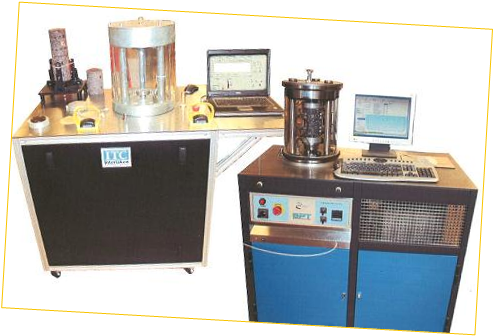
|
ARC Members Evaluate Flow Number Methods
As the Asphalt Mixture Performance Tester (AMPT) has become more widely accepted for measuring the dynamic modulus and rutting resistance of asphalt concrete mixtures, one shortcoming has become increasingly apparent. Not fully addressed during the AMPT’s development was standardized flow number (FN) testing and analysis to determine an asphalt mixture’s rutting resistance. The FHWA Mixture and Construction Expert Task Group (ETG) has determined that the need for flow number standards is critical, especially as they relate to performance testing in asphalt mixture design and acceptance. ARC members are on board with the effort.
Several promising approaches to flow number testing have been used by researchers since the AMPT’s development in NCHRP Projects 9-19 and 9-29. Now the Mixture and Construction ETG has initiated a study to evaluate these flow number procedures and criteria to determine which warrant further development and implementation. The Asphalt Research Consortium’s (ARC) Dr. Ramon Bonaquist of Advanced Asphalt Technologies (AAT) designed the study. AAT, ARC member University of Nevada, Reno (UNR) and others are evaluating the following five flow number approaches using asphalt mixtures known to have good rutting resistance for their design traffic level.
|

|
Through Transportation Pooled Fund Study TPF-5(178), “Implementation of the Asphalt Mixture Performance Tester for Superpave Validation,” the FHWA is helping 25 highway agencies acquire AMPTs and training, and is coordinating a national effort to get AMPTs into use for assessing asphalt mixture performance over a wide range of climatic conditions, materials, and structures.
|
|
Interlaken AMPT |
|
IPC Global AMPT |
|
NCHRP 9-33: Minimum values for flow numbers as a function of design traffic level are recommended (AAT 2011). Those values are based on a relationship between FN values and maximum allowable traffic level, which is estimated using the resistivity/rutting model developed in NCHRP Projects 9-25 and 9-31 (Christensen and Bonaquist 2006) then subsequently improved in NCHRP Project 9-33 (AAT 2011) and Airfield Asphalt Pavement Technology Program Project 04-02 (Christensen et al. 2008).
NCAT: Correlations between FN test results of hot mix asphalt (HMA) mixes and their field performance were developed by comparing FN values for plant-produced laboratory-compacted specimens to field-measured rut depths in newly constructed surface mixes at the 2006 NCAT Pavement Test Track (Willis et al. 2010).
NCHRP 9-30A: The MEPDG does not use FN as one of the mixture inputs, but uses results from repeated load permanent deformation tests to determine the coefficients to the rut depth transfer function included in the software. These coefficients to the transfer function are then adjusted or shifted to field conditions. These shift factors and the associated rutting susceptibility limits were developed using multiple test sections included in the FHWA-LTPP program and other full-scale test track test sections (Von Quintus et al. 2012). Hence, using results from the FN test, a mixture’s resistance to rutting can be evaluated without running the MEPDG for all trial mixture designs.
UNR: Every HMA has a unique critical combination of temperature and loading rate at which the mixture becomes unstable. Researchers at UNR recommend that the critical combination of temperature and loading rate be identified for
every HMA mixture. Once the critical condition is identified, it can be checked against the expected conditions where the HMA mix will be placed. An HMA mix should not be placed at locations where its critical condition is expected to be violated. A mixture will become unstable under a fixed loading rate when the effective annual asphalt pavement temperature for rutting exceeds the mixture critical temperature (Hajj et al. 2012).
AAPRL: As part of NCHRP 9-26A, several factors for improving the FN test were investigated. These included the test method, the analysis technique, and the relationship between laboratory and field performance. The results showed that the minimum strain rate at flow correlates well with the flow number. Also, the variability of minimum strain rate values was found to be less than the variability of the flow numbers. Therefore, the minimum strain rate could be a reliable parameter for the FN test.
A Closer Look at the Flow Number Methods |
|
1 The flow number testing conditions for each mixture (i.e. deviator and confining stresses and pulse duration) are determined at the temperature of interest using the predictive equations developed by Hajj et al. (2010a, 2010b). |
|
Frank Fee, chairman of the Asphalt Mixture and Construction ETG, arranged for materials from throughout the United States to be sent to the Western Regional Superpave Center at UNR and the Advanced AASHTO Pavement Research Laboratory (AAPRL) in Maryland for flow number testing. Dr. Elie Hajj of UNR and Dr. Haleh Azari of AAPRL presented preliminary flow number test results to the Asphalt Mixture and Construction ETG at its March 2012 meeting in Baton Rouge, Louisiana.
Members of the Mixture and Construction ETG Task Force are analyzing the flow number data and will present their findings at the ETG’s September 2012 meeting. When the Asphalt Mixture and Construction ETG makes its final recommendations on flow number testing, Dr. Bonaquist will help prepare a standard practice for submission to AASHTO, which is the first step toward establishing a Provisional Standard Practice. |
|
A Closer Look at the Asphalt Mixtures
|
|
References
AAT, Advanced Asphalt Technologies, LLC (2011). “A Manual for Design of Hot Mix Asphalt with Commentary,” NCHRP Report 673, Transportation Research Board, Washington, D.C., 273 pp. Christensen, D. W., and R. F. Bonaquist (2006). “Volumetric Requirements for Superpave Mix Design,” NCHRP Report 567, Transportation Research Board, Washington, D.C., 46 pp. Christensen, D. W., Bahia, H. U. and R. D. McQueen (2008). “PG Binder Grade Selection for Airfield Pavements,” Revised Final Report, Airfield Asphalt Pavement Technology Program Project 04-02, 133 pp. Hajj, E. Y., Ulloa, A., Siddharthan, R., and P. E. Sebaaly (2010a). “Estimation of Stress Conditions for the Flow Number Simple Performance Test,” Transportation Research Record: Journal of the Transportation Research Board, No. 2181, Vol. 3, Transportation Research Board of the National Academies, Washington, D.C., pp. 67-78. Hajj, E. Y., Ulloa, A., Siddharthan, R., and P. E. Sebaaly (2010b). “Characteristics of the Loading Pulse for the Flow Number Performance Test,” J. of the Ass. of Asphalt Paving Technologists, AAPT, Vol. 79, pp. 253-294. Hajj, E. Y., Ulloa, A., and P. E., Sebaaly (2012). “Flow Number Experiment: Asphalt Mixtures Critical Temperatures for Rutting Evaluation,” Final Report, FHWA Asphalt Mixture and Construction Expert Task Group. NCHRP, Data Mining and Interlaboratory Studies to Prepare Precision Statements for AASHTO Standards, National Cooperative Highway Research Program Project 9-26A, Transportation Research Board, Washington, D.C. Von Quintus, H., Mallela, J., Bonaquist, R., Schwartz, C., and R. L. Carvalho (2012). “Calibration of Rutting models for Structural and Mix Design,” NCHRP Report 719, Transportation Research Board, Washington, D.C., 207 pp. Willis, J.R., Taylor, A., Tran, N., Kvasnak, A., and A. Copeland (2010). “Correlations Between Flow Number Test Results and Field Performance at the NCAT Pavement Test Track,” Paper Submitted to the Transportation Research Board 89th Annual Meeting, Washington, D.C. |
|
Members of the Asphalt Mixture and Construction ETG Flow Number Task Force
Haleh Azari Advanced AASHTO Pavement Research Laboratory
Phil Blankenship Asphalt Institute
Ramon Bonaquist Advanced Asphalt Technologies, LLC
Raj Dongré Dongré Laboratory Services, Inc.
Elie Hajj University of Nevada, Reno
Richard Kim North Carolina State University
Gerald Reinke Mathy Technology and Engineering Services, Inc.
Nam Tran National Center for Asphalt Technology
Harold Von Quintus Applied Research Associates
Kevin VanFrank Utah Department of Transportation
|

|
Flow Number Method |
Air Voids |
Temperature |
Confining Stress, psi |
Deviatoric Stress, psi |
Pulse |
Criteria |
|
NCHRP 9-33 |
7% |
50% reliability high pavement temperature from LTPPBind 3.1 at depth of 20 mm for surface courses and top of layer for other layers |
0 |
87 |
0.1 sec with 0.9 sec dwell |
Flow number > critical value as a function of traffic |
|
NCAT |
7% |
50% reliability PG grade from LTPPBind 3.1 minus 6 °C |
10 |
70 |
0.1 sec with 0.9 sec dwell |
Flow number > critical value as a function of traffic and allowable rut depth |
|
NCHRP 9-30A |
Average In Place (Specs.) |
Option A: 3 Temps. (50% reliability PG grade from LTPPBind 3.1 minus 5°C, 20°C, and mid range). Option B: Effective temperature based on rutting (MEPDG). |
10 |
70 |
0.1 sec with 0.9 sec dwell |
Slope and intercept of permanent deformation curve < critical values as a function of traffic (rut depth < design threshold value). |
|
UNR |
Average In Place (Specs.) |
Effective pavement temperature defined as the equivalent annual asphalt pavement temperature that will result in a 90% reliability rut depth (MEPDG) of 0.25 or 0.50 inch at the end of the design period (e.g. 20 years). |
Variable1 |
Variable1 |
Variable1 |
Asphalt mixture critical temperature > effective pavement temperature for selected rut depth criterion |
|
AAPRL |
7% |
3 temperatures: Binder high PG, PG minus 6°C, PG minus 12°C |
10 |
70 |
0.1 sec with 0.9 sec dwell |
Rutting calculated from Minimum Strain Rate at 3 temperatures, aging index, and pavement temperature frequencies < critical rutting |
|
Mix # |
Design Traffic Level |
State |
Project Location |
Contact |
|
1 |
<3 |
Wisconsin |
Clifton St., City of Tomah USH 12 |
Erv Dukatz Mathy Construction |
|
2 |
<3 |
North Carolina |
River Road, Wilmington |
Todd Wittington NCDOT |
|
3 |
<3 |
Texas |
183N Brownwood |
Paul Hoelscher TXDOT |
|
4 |
3-10 |
Wisconsin |
I39/USH 51 Rhinelander-Wisconsin Rapids |
Erv Dukatz Mathy Construction |
|
5 |
3-10 |
Indiana |
US Route 136, just west of Crawfordsville |
Bill Pine Heritage Research |
|
6 |
10-30 |
Florida |
I-75 Hernando County Florida. Nearest city: Brooksville |
Jim Musselman FLDOT |
|
7 |
>30 |
New Jersey |
I80 Resurfacing – Hope to Ledgewood |
Eileen Sheehy NJDOT |
|
8 |
>30 |
Alabama |
NCAT Pavement Test Track |
Randy West NCAT |
|
9 |
>30 |
California |
SR 46 from PM 0 to 7.3. Kern/ San Luis Obispo County Line to Just West of Kecks Road |
Adam Hand Granit Construction |